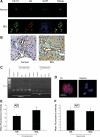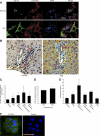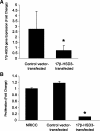Castration inhibits biliary proliferation induced by bile duct obstruction: novel role for the autocrine trophic effect of testosterone
- PMID: 21903763
- PMCID: PMC3233786
- DOI: 10.1152/ajpgi.00061.2011
Castration inhibits biliary proliferation induced by bile duct obstruction: novel role for the autocrine trophic effect of testosterone
Abstract
Increased cholangiocyte growth is critical for the maintenance of biliary mass during liver injury by bile duct ligation (BDL). Circulating levels of testosterone decline following castration and during cholestasis. Cholangiocytes secrete sex hormones sustaining cholangiocyte growth by autocrine mechanisms. We tested the hypothesis that testosterone is an autocrine trophic factor stimulating biliary growth. The expression of androgen receptor (AR) was determined in liver sections, male cholangiocytes, and cholangiocyte cultures [normal rat intrahepatic cholangiocyte cultures (NRICC)]. Normal or BDL (immediately after surgery) rats were treated with testosterone or antitestosterone antibody or underwent surgical castration (followed by administration of testosterone) for 1 wk. We evaluated testosterone serum levels; intrahepatic bile duct mass (IBDM) in liver sections of female and male rats following the administration of testosterone; and secretin-stimulated cAMP levels and bile secretion. We evaluated the expression of 17β-hydroxysteroid dehydrogenase 3 (17β-HSD3, the enzyme regulating testosterone synthesis) in cholangiocytes. We evaluated the effect of testosterone on the proliferation of NRICC in the absence/presence of flutamide (AR antagonist) and antitestosterone antibody and the expression of 17β-HSD3. Proliferation of NRICC was evaluated following stable knock down of 17β-HSD3. We found that cholangiocytes and NRICC expressed AR. Testosterone serum levels decreased in castrated rats (prevented by the administration of testosterone) and rats receiving antitestosterone antibody. Castration decreased IBDM and secretin-stimulated cAMP levels and ductal secretion of BDL rats. Testosterone increased 17β-HSD3 expression and proliferation in NRICC that was blocked by flutamide and antitestosterone antibody. Knock down of 17β-HSD3 blocks the proliferation of NRICC. Drug targeting of 17β-HSD3 may be important for managing cholangiopathies.
Figures






Similar articles
-
Neuropeptide Y inhibits biliary hyperplasia of cholestatic rats by paracrine and autocrine mechanisms.Am J Physiol Gastrointest Liver Physiol. 2013 Aug 1;305(3):G250-7. doi: 10.1152/ajpgi.00140.2013. Epub 2013 May 23. Am J Physiol Gastrointest Liver Physiol. 2013. PMID: 23703654 Free PMC article.
-
Follicle-stimulating hormone increases cholangiocyte proliferation by an autocrine mechanism via cAMP-dependent phosphorylation of ERK1/2 and Elk-1.Am J Physiol Gastrointest Liver Physiol. 2009 Jul;297(1):G11-26. doi: 10.1152/ajpgi.00025.2009. Epub 2009 Apr 23. Am J Physiol Gastrointest Liver Physiol. 2009. Retraction in: Am J Physiol Gastrointest Liver Physiol. 2025 Jul 1;329(1):G160. doi: 10.1152/ajpgi.00025.2009_RET. PMID: 19389804 Free PMC article. Retracted.
-
Modulation of the biliary expression of arylalkylamine N-acetyltransferase alters the autocrine proliferative responses of cholangiocytes in rats.Hepatology. 2013 Mar;57(3):1130-41. doi: 10.1002/hep.26105. Epub 2013 Feb 7. Hepatology. 2013. PMID: 23080076 Free PMC article.
-
Development of 17β-hydroxysteroid dehydrogenase type 3 as a target in hormone-dependent prostate cancer therapy.Steroids. 2017 May;121:10-16. doi: 10.1016/j.steroids.2017.02.003. Epub 2017 Mar 4. Steroids. 2017. PMID: 28267564 Review.
-
Heterogeneity of the intrahepatic biliary epithelium.World J Gastroenterol. 2006 Jun 14;12(22):3523-36. doi: 10.3748/wjg.v12.i22.3523. World J Gastroenterol. 2006. PMID: 16773709 Free PMC article. Review.
Cited by
-
Autocrine regulation of biliary pathology by activated cholangiocytes.Am J Physiol Gastrointest Liver Physiol. 2012 Mar 1;302(5):G473-83. doi: 10.1152/ajpgi.00482.2011. Epub 2011 Dec 22. Am J Physiol Gastrointest Liver Physiol. 2012. PMID: 22194419 Free PMC article. Review.
-
Sex Hormone-Dependent Physiology and Diseases of Liver.Int J Environ Res Public Health. 2020 Apr 11;17(8):2620. doi: 10.3390/ijerph17082620. Int J Environ Res Public Health. 2020. PMID: 32290381 Free PMC article. Review.
-
The physiological roles of secretin and its receptor.Ann Transl Med. 2013 Oct;1(3):29. doi: 10.3978/j.issn.2305-5839.2012.12.01. Ann Transl Med. 2013. PMID: 25332973 Free PMC article. Review.
-
Recent advances on the mechanisms regulating cholangiocyte proliferation and the significance of the neuroendocrine regulation of cholangiocyte pathophysiology.Ann Transl Med. 2013 Oct;1(3):27. doi: 10.3978/j.issn.2305-5839.2012.10.03. Ann Transl Med. 2013. PMID: 25332971 Free PMC article. Review.
-
Are Gender Differences Important for Autoimmune Liver Diseases?Life (Basel). 2024 Apr 12;14(4):500. doi: 10.3390/life14040500. Life (Basel). 2024. PMID: 38672770 Free PMC article. Review.
References
-
- Alpini G, Glaser S, Robertson W, Phinizy JL, Rodgers RE, Caligiuri A, LeSage G. Bile acids stimulate proliferative and secretory events in large but not small cholangiocytes. Am J Physiol Gastrointest Liver Physiol 273: G518– G529, 1997 - PubMed
-
- Alpini G, Glaser S, Ueno Y, Pham L, Podila PV, Caligiuri A, LeSage G, LaRusso NF. Heterogeneity of the proliferative capacity of rat cholangiocytes after bile duct ligation. Am J Physiol Gastrointest Liver Physiol 274: G767– G775, 1998 - PubMed
-
- Alpini G, Phinizy JL, Glaser S, Francis H, Benedetti A, Marucci L, LeSage G. Development and characterization of secretin-stimulated secretion of cultured rat cholangiocytes. Am J Physiol Gastrointest Liver Physiol 284: G1066– G1073, 2003 - PubMed
-
- Alpini G, Prall RT, LaRusso NF. The pathobiology of biliary epithelia. The Liver; Biology & Pathobiology (4th ed.), edited by Arias IM, Boyer JL, Chisari FV, Fausto N, Jakoby W, Schachter D, Shafritz DA. Philadelphia, PA: Williams & Wilkins, 2001, p. 421–435
Publication types
MeSH terms
Substances
Grants and funding
LinkOut - more resources
Full Text Sources
Research Materials

